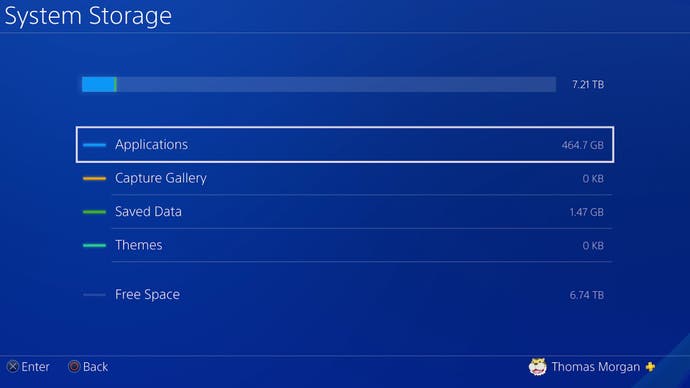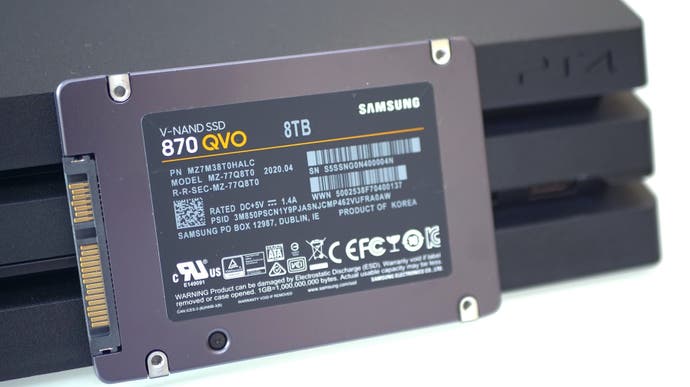We upgraded PS4 Pro with an 8TB SSD: can we make a better console?
Faster load times, improved streaming: the ultimate storage upgrade benchmarked.
Way back in 2013, the idea of upgrading a PlayStation 4 with solid-state storage was an option - but not a realistic one when the cost per gig was so prohibitively expensive. Today though, SATA-based SSDs are more affordable and as developers push the hard drive harder, loading times and streaming issues are more prevalent. We've been asked to revisit SSD performance for PS4 for some time - and to do so, we've deployed a nuclear option: Samsung's new 870 QVO SSD. To test PS4 SSD performance to its ultimate potential, we effectively have an eight terabyte console. Even factoring in reserved space, we should be getting an order of magnitude more storage than the 825GB PlayStation 5.
To put the drive more fully through its paces, we opted to install it in PlayStation 4 Pro where its SATA-3 interface could perhaps offer more bandwidth and where the faster 2.13GHz AMD Jaguar CPU cores should crunch through compressed data far more quickly. It's the best way possible to enhance the console - but what advantages does it actually deliver? Can we address the long load times of games like The Witcher 3? Can we mitigate the ugly pop-in issues in Final Fantasy 7 Remake? And crucially, what's the difference between running this beast as a USB add-on drive as opposed to using it to replace the internal stock hard drive? These are the questions we've been asked over the months and now we've got some answers.
You can find out more about the Samsung QVO line in prior coverage but how it achieves its remarkable level of storage is fascinating and indeed controversial. Along with other recent high capacity drives, QLC NAND is used, allowing four bits per cell (as opposed to the two to three bits in prior NAND technology). This is combined with the vertical stacking of memory modules to increase storage density. The downside to QLC NANDs is slower read and write speeds but Samsung mitigates this with a large DRAM cache - 8GB in the case of the 8TB QVO 870. Samsung promises a max read of 560MB/s and write of 530MB/s - and our tests pull respectably close to both. There are concerns about QLC NAND's longevity in terms of endurance but that's unlikely to be a concern on games console where data is written relatively infrequently.
Previous tests have demonstrated that consoles never use the full extent of an SSD's speed boost vs the same drive running in a PC, but there is perhaps room for improvement here. When used as external storage via USB, the same drive should be hot-swappable between PS4 and PS5 and with the new architecture, we should expect to see a higher bandwidth USB interface along with a far faster processor to decompress incoming data. You won't be able to use an external SATA SSD to run PS5 games but there could be good benefits for faster loading and better streaming for your existing PS4 library.
We'll kick off the tests with the crucial loading times - tested with the SSD mounted within PS4 Pro, and also attached via a USB to SATA connector and configured as extended storage. In an era where some loading times can exceed one minute or even 90 seconds, there must surely be scope for improvement - and the good news is that an SSD can deliver some excellent returns. With the Samsung drive installed internally, loading up our Novigrad save game in The Witcher 3 delivers a 32 per cent reduction in loading times.
There's a nice boost to fast travel times too, and this does make playing the game a little more pleasurable to the experience of dropping in out of regions on the map. However, even with the SSD, we're still looking at loading times in excess of a minute - and the same drive handling the same task in the same game on PC does this a lot, lot more quickly. Again, I do have to wonder whether PlayStation 5 will do better here under backwards compatibility.
To see another big upgrade, Battlefield 5 is worth a look. Booting a War Stories mission in Nordlys usually takes a whole 60 seconds to get to any gameplay, but the SSD cleaves that straight in half to 30 seconds. Other missions see even greater gains - the next mission along, Tirailleur, hits the same 30 seconds figure on an SSD, down from 66 seconds on stock. All of which gives us an extreme cut in loading times: 45 per cent of the wait you'd experience on the stock HDD. To pick another title with a big opening load ahead of a sprawling open field, we have Day's Gone, again making a significant improvement with a reduction from 87 seconds down to 47.
| Loading Times (Seconds) | PS4 Pro Stock 1TB HDD | 870 QVO 8TB SSD: External | 870 QVO 8TB SSD: Internal |
|---|---|---|---|
| Battlefield 5: Mission 3 Nordlys | 59.35 | 34.46 | 30.10 |
| Battlefield 5: Mission 4 Tirailleur | 66.04 | 36.18 | 31.01 |
| The Witcher 3: Novigrad Centre | 91.20 | 67.46 | 62.36 |
| The Witcher 3: White Orchard | 40.43 | 22.52 | 22.46 |
| Bloodborne: Iosefka's Office (From Hunter's Dream) | 23.45 | 12.05 | 13.38 |
| Bloodborne: Central Yharnam (From Hunter's Dream) | 25.22 | 13.37 | 15.34 |
| Fallout 4: Diamond City | 44.39 | 19.44 | 14.18 |
| Fallout 4: Commonwealth | 48.25 | 23.01 | 20.49 |
| Gran Turismo Sport: Sunday Cup 3 Dragon's Tail | 22.49 | 20.17 | 20.24 |
| Gran Turismo Sport: Sunday Cup 4 Alsace | 19.25 | 17.58 | 17.36 |
| Final Fantasy 7 Remake: Sector 7 Slums Residential Area | 33.29 | 20.55 | 19.54 |
| Final Fantasy 7 Remake: Sector 5 Slums Church | 24.31 | 17.17 | 16.08 |
| Day's Gone: 1st Mission Load | 87.28 | 50.16 | 47.16 |
Plenty of other titles show off the merits of the SSD. Bloodborne, Final Fantasy 7 Remake and Gran Turismo Sport all see improvements to varying degrees - shown below. Perhaps the best one to call out from the bunch is Fallout 4, a game that does involve entering and leaving interiors, like Diamond City, which cues up some lengthy loads. In this case, loading our Diamond City save takes just 14 seconds on the internal SSD, down from 44 seconds usually. That gets us our biggest relative saving, at 32 per cent of the overall load time. Again, impressive stuff for the SSD - and even accessed via USB it's a remarkable gain.
In terms of how game loading times compare with the SSD mounted internally or connected via USB, our results demonstrate that there is indeed an advantage in going through the upgrade procedure and removing your stock HDD completely, but the results are variable. Looking at our Final Fantasy 7 Remake result, the load time is just one second faster than using the same drive externally via USB - 19.5 seconds vs 20.6. Bizarrely, in Bloodborne, both of our loading time tests saw the internal result being one to two seconds slower. However, elsewhere, the scores were either on par or significantly better. Our Witcher 3 Novigrad save test saw an internal SSD lop off five seconds from the external result. Similarly, we saw three to five second gains in Fallout 4 loading. That may not sound too amazing but when the load times are in the 20 second range with the external SSD, an extra three to five second time saving is proportionally very impressive.
If I were doing the upgrade, I'd likely opt to mount the drive internally to get as much performance back as possible from what is, after all, a very expensive upgrade. However, external USB storage has a key advantage - as long as you're using the same PSN login, you can share the drive between multiple consoles... and this should include PlayStation 5.
The next big question then: can upgrading to an SSD improve the actual playing experience? Games rely heavily on streaming, and in his recent Road to PS5 presentation, Mark Cerny explained the many challenges of working with a mechanical hard drive. Moving to SSD effectively eliminates the bottlenecks inherent in the hard drive. We've see a raft of games battle with the seek times of the PS4's internal HDD in this sense, like Final Fantasy 7 Remake's slum area, for example. The results are usually mitigated by buffering data in the background into system RAM but games like Final Fantasy 7 Remake still clearly depend on the drive for streaming some assets. The result is glaring pop-in, and textures that at times do not load until you've walked right past them.
Tests at the time of review were inconclusive, but a more detailed look with the QVO 870 does seem to show clear and dramatic boost to texture loading and even a noticeable upgrade in geometry pop-in. There's also a good improvement in The Witcher 3's more challenging areas too. Galloping from the outskirts of the Novigrad region to the inner city, this run is a perfect stress test for a stock PS4 Pro drive versus an SSD. Again, there's an undeniable upgrade here. Much like Final Fantasy 7 Remake, textures on building sides can't load in time on the stock PS4 Pro HDD, leaving a blurry mess on the first run, with no problem at all on SSD. There are no improvements to geometry pop-in, however.
Other more subtle improvements are also evident. On Day's Gone, there are some improvements to texture pop-in during cutscenes. Then there's the storage-bound monster that is Fallout 4. We run a set route of the commonwealth just outside Diamond City, and again, textures underfoot fail to resolve in time as we run over the terrain while the SSD saves the day yet again - faster seek times to its flash memory serve up the assets faster.

So, the evidence for an SSD upgrade is looking good then. Loading times aren't improved in step with the generational leap in hardware performance, but they are substantially better. On the titles most egregiously impacted by asset pop-in, we can confirm that there are improvements. We are using what may well be the best possible SSD for the job here with a storage level that commands a stratospheric price-point but smaller capacity drives are available and the storage-side bottleneck should be mostly eliminated even on much cheaper SSDs.
But one lingering question we've been asked many times concerns the PS4's front-end menus, which can get a little laggy. Using the SSD as external storage won't mitigate this, but the theory is that using it internally will. Well, from a cold boot, PS4 Pro gets to the menus much faster than it does on stock - and likewise for switching between games. It's a swifter process on the SSD with less stutter. That's the extent of it though in our testing; for actual menu navigation there's only small gains in smoothness. Most elements of PS4's UI are more dependant on network speed, like the tiles of your games library, or the social details under each game. An upgrade to an SSD - either external, or installed internally - doesn't make a huge difference in this sense. Really, the biggest upgrade relates to the loading speeds.
Ultimately, at the beginning of the generation, the concept of upgrading to an SSD for PlayStation 4 perhaps didn't make a lot of sense. However, the arrival of the enhanced machines, the drop in prices and the fact that developers are clearly pushing storage to breaking point helps to make the case somewhat more compelling. As for spending £800/$900 on an 8TB Samsung drive - well, it's difficult to justify but just seeing whether it would work has been reward enough. And yes, all of the results we've collected will be revisited once we have PlayStation 5 in our possession. I'm hopeful we'll see a further uptick in loading speeds and also in streaming quality for assets - all areas we'll be investigating once the new console lands a few months from now.














